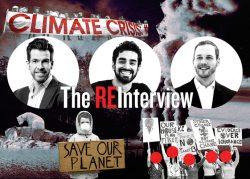In real estate, green isn’t the new black — not yet. But if the capital markets continue demanding greater sustainability and increasing the pressure on portfolios with high carbon emissions, it may soon be impossible for owners to stay in the black if they don’t go green.
Last month, many of the global economy’s movers and shakers convened with heads of state and policymakers at the United Nations climate change conference, known as COP26. Pledges were made, speeches were given, and urgent statements about the need to tackle the climate crisis were issued. But did anything substantial emerge that the real estate industry — a leading contributor to climate change — can act upon?
“At anything like this, there is going to be a certain amount of rhetoric,” said Greg Smithies, who co-heads the climate tech team at real estate–focused venture capital firm Fifth Wall and was in Glasgow for the conference. “However, there were significant, put-the-pedal-to-the-metal things that need to happen that were discussed that are most relevant to our industry.”

Greg Smithies, Fifth Wall
Fifth Wall has announced commitments of over $300 million to its climate tech fund from industry players such as Invitation Homes, Equity Residential, Hudson Pacific Properties and Ivanhoe Cambridge, as well as New Zealand’s pension fund. It’s looking to deploy that money into companies that develop and scale technologies that can decarbonize the industry.
I caught up with Smithies to understand what sprung out of COP26 that might move the needle for real estate, and what positives he found in a conference that was maligned as “all talk, no action.”
Did real estate have a real seat at the table this time? Did it send executives with check-signing power and ability to influence decision-making?
Traditionally, these conferences have not had a lot of industry representation. But of every person I was talking to, about half of them were from industry, and the titles were VP-level and above, up into C-level. So overall, industry exposure and industry presence here was much larger than we’ve seen in previous years.
How substantive were the discussions? Was it more “climate change is an existential threat” or more actionable, like, “Let’s set up some meetings, let’s talk to some companies?”
Refrigerants in old-world HVAC and air-conditioning systems are 10,000 times worse for global warming than CO2 is. Leading up to COP26, we saw a bunch of new global regulations around refrigerants. We’ve also seen regulations on methane, which is five to six times worse for global warming than CO2 is. Our buildings consume a lot of natural gas in heating, so this is very relevant to us.
“Buildings are worth less if they’re underwater or on fire.”
Equally important is cost of capital. When you think of how all of the money flows into the real estate industry, it flows from the sovereign wealth funds, from the pension funds, into the fund of funds and then into the capital markets and into the REITs. But the tails that wag the dog are these massive global pension and sovereign pools of capital. And what we saw coming out of COP is the number of those organizations making ESG pledges, making carbon-zero pledges, exploding. We’re ultimately going to see an acceleration of the trend that if you have clean, green buildings, your cost of capital should come down.
In 2020, BlackRock’s Larry Fink dropped a bomb by saying that his firm would avoid investments in companies that “present a high sustainability-related risk.” What’s the latest iteration of that?
The most recent numbers are that about 40 percent of the world’s total assets under management are now investing under some kind of an ESG mandate. Basically $1 in every $3 out there is searching for clean, green projects. That’s just on your cost-of-capital side.
At the same time, from a resiliency standpoint, buildings are worth less if they’re underwater or on fire. You’ve got $326 trillion worth of buildings out there, which means that buildings are typically the largest pool of risk that the insurance industry has. The insurance industry is now also reframing all of their underlying actuarial models to take into account climate risk.
And this is one of the other big takeaways coming out of COP: It’s very difficult to make any money on a building if you can’t insure it and therefore you can’t lease it out. So the estimates coming out of COP are that over the next 20 years, somewhere around $14 trillion of buildings globally are going to become uninsurable.
Another big discussion seems to have been around a global framework for carbon trading.
This ultimately is going to have the biggest impact for our industry. The trading of carbon offsets and carbon credits has been very insular to certain markets — there’s a market in California, and New York’s thinking of setting up one, Europe has their own market. In the capital markets, it’s very difficult to have futures in anything if you’ve got multiple disparate markets.
What happened right at the end of COP26 was that all 190 countries agreed on a basic framework that will set in place the ability for us to start having standardization of these assets, so that we can actually have a global carbon market. Just like trading stocks, you know, between the London Stock Exchange and the New York Stock Exchange.
Read more about the intersection between real estate and climate change


You need some sort of LIBOR…
Exactly. What came out of COP is we actually do now have a LIBOR. The framework which ultimately sets us up to have a global market.
One big headline was this $130 trillion Net Zero Alliance, championed by Brookfield’s Mark Carney. What’s your take on that number – is it hot air?
There are shades of gray. Any time you bring together a pool of capital as large as what they’re talking about, there’s a tradeoff between size of pool versus specificity of the focus on climate. If you have a pool of capital that big, that means it can’t be highly focused on true climate-type things. At the same time, it’s important for people to see that there is momentum around the space and people leaning in. You need the market to move in this direction so that the average company out there can say, “OK, we can justify spending on clean, green things because we know the investors wanted it — just look at the Net Zero Alliance.”
How much of the discussion was about deploying existing technology versus R&D into new climate tech?
There were statements made, for example, by John Kerry, that our existing technology can only solve about 50 percent of the problem. Therefore we need to also be investing in R&D. What we’ve seen is basically a double underline on that, that the existing technologies we have and all of the policies to drive that deployment and for companies to get, say, tax breaks for buying them, is important, but it only solves about half of the problem. Therefore governments should also be doing things like putting money into R&D to get technologies out of the lab and to industrial scale.
How about from the private-sector perspective, in terms of investing in climate tech for real estate?
If you look at the balance sheet of the real estate industry, overall spend into R&D is zero. But there is this slow awakening that if you’ve signed up for some kind of carbon pledge — which you probably have, because your investors are demanding it, or you’re chasing a smaller cost of capital — that you cannot get there with existing technologies. Therefore you have to go and invest in R&D to help develop new technologies.
rnrn“We made a bunch of very good steps — refrigerants and methane regulations, frameworks for carbon trading. Where we missed out is setting a global CO2 price.”rnrn
Our hypothesis is that even in the real estate industry, it’s the people who get good at R&D spending who are going to be the leaders in this field.
What would you have liked to see from this conference? What, in terms of topics relevant to the industry, was lacking?
I actually went in with very low expectations. The problem is, it had been built up like, “This is our last best hope, and if we don’t nail everything right now, we’re completely screwed.” Realistically, these things move in steps. We made a bunch of very good steps. Refrigerants and methane regulations, frameworks for carbon trading, great.
Where we did miss out is a global CO2 price. Say if Europe is going to put a price, where they’re going to tax people who are making dirty steel, then you also want them to, say, put a price on when steel from China comes in, in order to put those two manufacturers on an equal basis. We did not see good frameworks like that being put into place.
And what’s Fifth Wall’s position in all of this? How did you spend your days at COP26?
Real estate is a global industry. It’s the largest asset class in the world. And in most countries it’s 10 to 20 percent of GDP. Any time that any of these countries’ finance ministers or anyone is writing policies, the real estate industry should be there. Historically, as an industry we have been bad at banding together and getting a seat at the table. The primary thing that we were trying to do was to be an emissary for the industry, to try to ensure that it does have a seat at the table in these sorts of discussions where historically we’ve punched below our weight.
Real estate tends to punch above its weight at the municipal level, but not at the international level. Most of the largest real estate companies haven’t really signed up for this whole climate tech thing, haven’t signed up to shape climate policy.
We would like to inspire more of the industry to join the consortium that we’re building. But just because we don’t have most of the industry signed up doesn’t mean that we can’t start going and kicking the hornet’s nest a little bit with the national and the global regulators, to get a seat at that table.
This interview has been condensed and edited for clarity.
(Write to Hiten Samtani at hs@therealdeal.com. To check out The REInterview, a series of his in-depth conversations with real estate leaders and newsmakers, click here.)